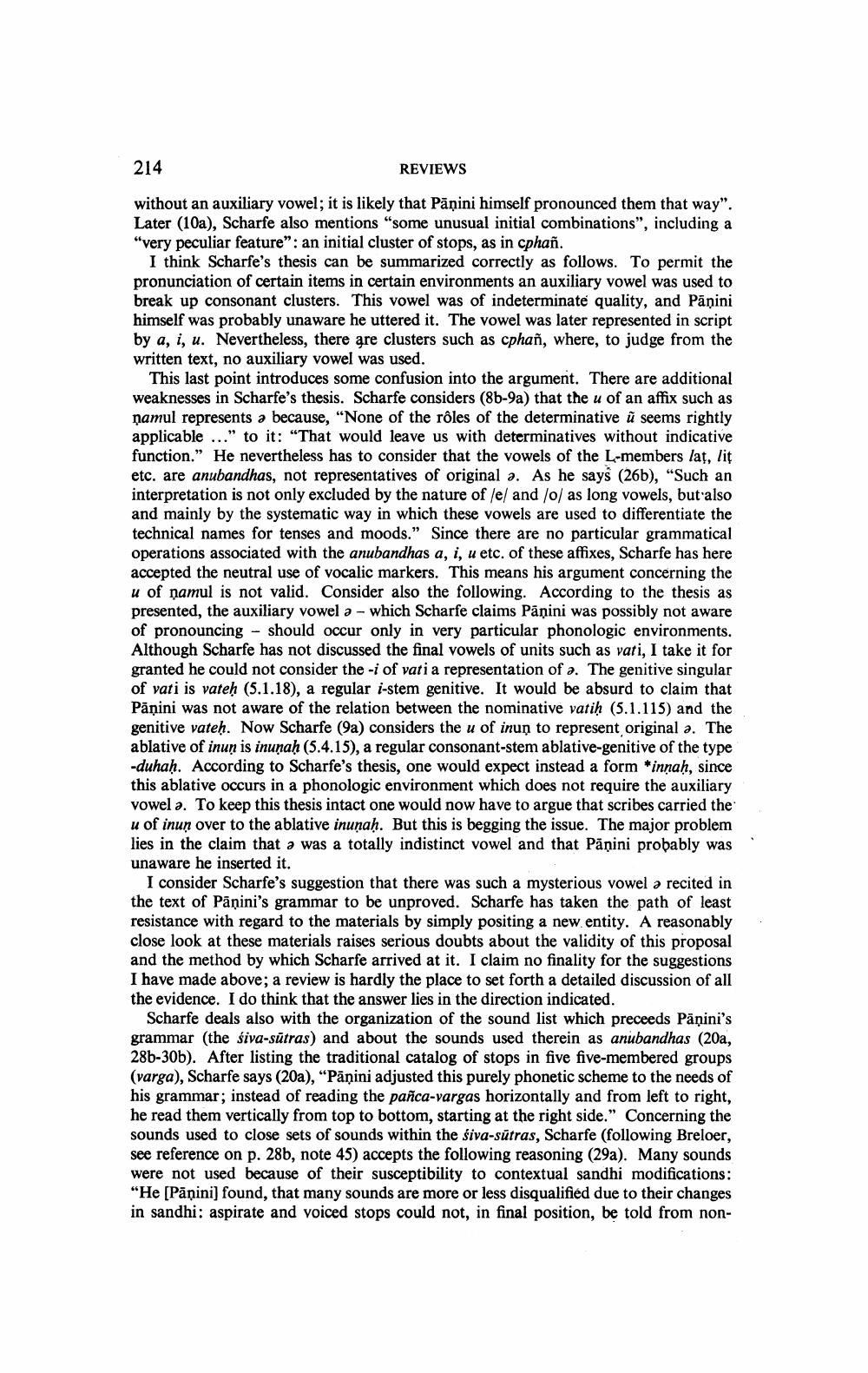________________ 214 REVIEWS without an auxiliary vowel; it is likely that Panini himself pronounced them that way". Later (10a), Scharfe also mentions "some unusual initial combinations", including a "very peculiar feature": an initial cluster of stops, as in cphan. I think Scharfe's thesis can be summarized correctly as follows. To permit the pronunciation of certain items in certain environments an auxiliary vowel was used to break up consonant clusters. This vowel was of indeterminate quality, and Panini himself was probably unaware he uttered it. The vowel was later represented in script by a, i, u. Nevertheless, there are clusters such as cphan, where, to judge from the written text, no auxiliary vowel was used. This last point introduces some confusion into the argument. There are additional weaknesses in Scharfe's thesis. Scharfe considers (8b-9a) that the u of an affix such as namul represents a because, "None of the roles of the determinative u seems rightly applicable ..." to it: "That would leave us with determinatives without indicative function." He nevertheless has to consider that the vowels of the L-members lat, lit etc. are anubandhas, not representatives of original a. As he says (26b), "Such an interpretation is not only excluded by the nature of /e/ and /o/ as long vowels, but also and mainly by the systematic way in which these vowels are used to differentiate the technical names for tenses and moods." Since there are no particular grammatical operations associated with the anubandhas a, i, u etc. of these affixes, Scharfe has here accepted the neutral use of vocalic markers. This means his argument concerning the u of namul is not valid. Consider also the following. According to the thesis as presented, the auxiliary vowel a - which Scharfe claims Panini was possibly not aware of pronouncing - should occur only in very particular phonologic environments. Although Scharfe has not discussed the final vowels of units such as vati, I take it for granted he could not consider the -i of vati a representation of a. The genitive singular of vati is vateh (5.1.18), a regular i-stem genitive. It would be absurd to claim that Panini was not aware of the relation between the nominative vatih (5.1.115) and the genitive vateh. Now Scharfe (9a) considers the u of inun to represent original a. The ablative of inun is inunah (5.4.15), a regular consonant-stem ablative-genitive of the type -duhah. According to Scharfe's thesis, one would expect instead a form *innah, since this ablative occurs in a phonologic environment which does not require the auxiliary vowel @. To keep this thesis intact one would now have to argue that scribes carried the u of inun over to the ablative inuna). But this is begging the issue. The major problem lies in the claim that a was a totally indistinct vowel and that Panini probably was unaware he inserted it. I consider Scharfe's suggestion that there was such a mysterious vowel a recited in the text of Panini's grammar to be unproved. Scharfe has taken the path of least resistance with regard to the materials by simply positing a new entity. A reasonably close look at these materials raises serious doubts about the validity of this proposal and the method by which Scharfe arrived at it. I claim no finality for the suggestions I have made above; a review is hardly the place to set forth a detailed discussion of all the evidence. I do think that the answer lies in the direction indicated. Scharfe deals also with the organization of the sound list which preceeds Panini's grammar (the siva-sutras) and about the sounds used therein as anubandhas (20a, 286-30b). After listing the traditional catalog of stops in five five-membered groups (varga), Scharfe says (20a), "Panini adjusted this purely phonetic scheme to the needs of his grammar; instead of reading the panca-vargas horizontally and from left to right, he read them vertically from top to bottom, starting at the right side." Concerning the sounds used to close sets of sounds within the siva-sutras, Scharfe (following Breloer, see reference on p. 28b, note 45) accepts the following reasoning (29a). Many sounds were not used because of their susceptibility to contextual sandhi modifications: "He [Panini] found, that many sounds are more or less disqualified due to their changes in sandhi: aspirate and voiced stops could not, in final position, be told from non




